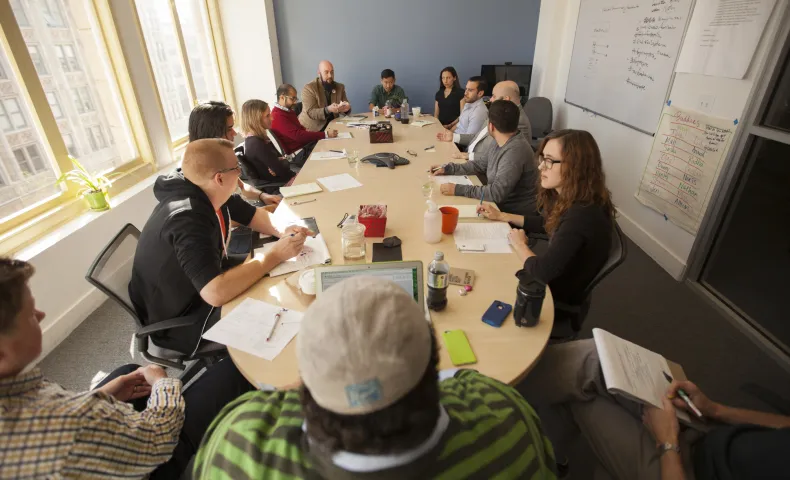 Photo by Theo Rigby
Photo by Theo Rigby
Making the Case for Nonprofit Leaders
This interview was originally published on the Social Velocity blog, here.
In today’s Social Velocity interview, I’m talking with Linda Wood, Director of the Haas Leadership Initiatives. Over the past decade, the Haas, Jr. Fund has invested over $20 million in strengthening the leadership of more than 75 grantees in its key priority areas—immigrant rights, education equity, and gay and lesbian rights—through the Flexible Leadership Awards program. In that time Linda has become a leading voice on the topic of leadership in the nonprofit and philanthropic sectors.
Nell: The Evelyn and Walter Haas, Jr. Fund has put a lot of investment behind the development of nonprofit leaders, but you are quite an anomaly in the philanthropic world. Support for leadership development is taken as a given in the for-profit world, but rarely recognized, let alone funded, in the nonprofit world. Why do you think there is that discrepancy in leadership development between the nonprofit and for-profit worlds?
Linda: It really is striking to see how differently the business sector and the nonprofit world view the issue of leadership. I went to business school myself, and spent eight years working as a management consultant in the private sector where it’s basic good practice to invest in the people you’re counting on to move the work forward. Strengthening leadership is seen as part and parcel of what it takes to fuel innovation and success.
On the other hand, in the social sector, a lot of foundations think of leadership development as a luxury–a nice-to-have that’s not linked to impact. That’s reflected in recent estimates that less than 1% of total foundation spending is going to strengthen leadership in the nonprofit sector.
Why? Well, I think we’ve got a lot of myths about leadership in our sector.
One myth is that leadership development is simply not a priority for nonprofit leaders because most don’t ask for it. And, when grantees don’t ask, many foundations assume that there’s no need. But we have not yet created a culture in the nonprofit sector that says it’s ok to invest in yourself and in other senior organizational leaders. We place a high value on self-sacrifice. Given the choice, nonprofit leaders will almost always direct general support to critical services and programs. That’s why actually I think it’s important for foundations to earmark funds for supporting leadership.
One myth is that leadership development is simply not a priority for nonprofit leaders because most don’t ask for it. And, when grantees don’t ask, many foundations assume that there’s no need. But we have not yet created a culture in the nonprofit sector that says it’s ok to invest in yourself.
Another related myth is that leadership is part of overhead, and overhead should be minimized at all costs. From this perspective, investments in the organization’s leadership are cleaved off from the work and seen as wasteful overhead rather than intrinsic to achieving the organization’s goals.
Nell: You recently curated a blog series on the Stanford Social Innovation Review where funders who have supported nonprofit leadership development articulated its value. How helpful do you think that step was in getting the broader philanthropic community to understand the value of leadership investment? And do you have additional plans to help move leadership development forward among your peers?
Linda: Our goal in putting together the SSIR blog series was to help build momentum around the idea of investing in leadership being a core grantmaking strategy that can catalyze diverse programmatic goals and not just a boutique strategy that only some funders can afford. By featuring perspectives from top-level executives from a half dozen foundations of very different sizes and with very different funding priorities, ranging from the Omidyar Network to the Women’s Foundation of California, we hoped to offer examples that would inspire more foundations to see possibilities for their own work.
To be honest, it’s hard to know whether we are moving the needle. But it does seem like there has been mounting attention to philanthropic underinvestment in leadership lately. Just over the past couple of months GEO and then NCRP have both released major reports making the case for more attention to leadership and talent development. And the Talent Philanthropy Project held a meeting in New York in March that attracted over 60 people including nonprofit leaders, funders, consultants, and intermediaries.
I think the real question is whether increased interest will translate into significant increases in investment—the kinds of sustained, strategic investments in leadership that advance the capacity of organizations, networks and movements to achieve better outcomes. The danger is that we foundations will sprinkle a little leadership development funding here and there, perhaps send a handful of our grantee leaders to a training, and call it a day.
The danger is that foundations will sprinkle a little leadership development funding here and there, perhaps send a handful of our grantee leaders to a training, and call it a day.
Nell: You recently announced a new initiative to seek solutions to the challenges, which you uncovered in your 2013 UnderDeveloped study with CompassPoint, facing nonprofit fundraising. What are your long-term plans with this initiative and what do you hope to find?
Linda: The UnderDeveloped report caused such a stir across the country. I have heard from so many people—funders, grantees, consultants, board members, etc.—that the report gave voice to concerns they’ve held for a long time. It clearly hit a pain point. And the big question it begs is what to do about it?
At the Haas, Jr. Fund, we’ve decided our next step is to try and refine concrete strategies that will help our grantees, and hopefully others, achieve breakthroughs in their fundraising.
One of our goals is to help organizations be more strategic about their approach to fund development. There’s so much out there. The nonprofit fundraising industry is full of consultants, speakers, large trade associations and technology providers. They offer costly, sometimes contradictory advice, patented approaches, one-off success stories, and a dizzying array of technology tools and platforms for raising money. As a result, our work in fundraising may be less about innovating and more about separating the wheat from the chaff, helping grantees chart a coherent, fruitful course through the thicket of possibilities.
Right now, we’re in the R & D phase. Here are some of the questions we’re exploring:
- What fundraising success stories can be replicated by our grantees? To answer this question, we will conduct “bright spots” research focused on small- to medium-sized organizations who have had sustained success with individual fundraising.
- How can we address the fundraising talent gap? To answer this question, we are conducting a scan of fundraising training and exploring the feasibility of a “fundraising fellowship.”
- One fund development approach that’s attracting attention is developing a “culture of philanthropy.” But what does that mean? And what difference does it make?
- Are there ways to help an entire field of grantees? To identify potential investments that might help a field of grantees, we are testing whether and how donor research can help LGBT grantees with fundraising.
As we tackle these questions, we are sharing what we’re learning along the way through a series of blogs on our website. And we’d love to hear from other people. What questions are missing? What can a foundation’s role be in supporting fundraising capacity?
Ultimately, this isn’t just an intellectual exercise. Our goal is to get better at supporting grantees around fund development, and to that end, we anticipate beginning to pilot some new strategies starting in 2016.
You asked what we hope to achieve with this work over the long term. I think if I could fast forward a couple of years, I would hope we will have made a dent in strengthening the talent pipeline for development directors, and that we are helping organizations bring more skill, focus and success to their fundraising, especially in tapping individual donors.
Nell: Philanthropy has traditionally been less interested in funding capacity building (like leadership development and fundraising). Do you think that’s changing? And/or do you think we will have more hope of changing that as generational shifts take hold in philanthropy?
Linda: Yes, I often feel like there’s a real divide between the folks in philanthropy who are focused on the what and those who are focused on the how.
Obviously, we’re all in this work for the what—to help create a more just and sustainable world. But often in philanthropy, conversations about things like capacity and leadership are disconnected from the conversations about the content of the work. We hold separate conferences; we belong to different affinity groups; we read different articles…
No matter what a given foundation seeks to achieve programmatically—whether that’s community health, environmental justice or education equity—it’s important to ask how they will get from where they are today to where they want to be.
So, as someone who’s a member of the how club (as we sometimes jokingly refer to it among ourselves) I think we need to keep strengthening the connection between building leadership and capacity and delivering programmatic wins. No matter what a given foundation seeks to achieve programmatically—whether that’s community health, environmental justice or education equity—it’s important to ask how they will get from where they are today to where they want to be. What is our responsibility as funders to support the people and organizations who are advancing this work? What kind of staff, board and community leadership will be needed to get where we all want to go? And how can we transmit in words and in concrete actions that we are in this together and that we want to provide them with the resources to do their best work.
